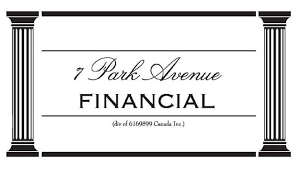|
Business Commercial Loan Options
Commercial Financing That Grows with Your Business, Not Against It
YOUR COMPANY IS LOOKING FOR BUSINESS CREDIT AND COMMERCIAL LOAN FINANCING!
BUSINESS LOANS AND LINES OF CREDIT
You've arrived at the right address! Welcome to 7 Park Avenue Financial
Financing & Cash flow are the biggest issues facing businesses today
ARE YOU UNAWARE OR DISSATISFIED WITH YOUR CURRENT BUSINESS FINANCING OPTIONS?
CONTACT US
CALL NOW - DIRECT LINE - 416 319 5769 - Let's talk or arrange a meeting to discuss your needs
EMAIL - sprokop@7parkavenuefinancial.com

ACCESSING COMMERCIAL LOANS IN CANADA
7 Park Avenue Financial originates business financing solutions for Canadian Businesses – We offer Business Commercial Loans and working capital solutions – Save time, and focus on profits and business opportunities
7 Park Avenue Financial: “Canadian Business Financing with the intelligent use of experience”
As a Canadian business owner and financial manager, you realize you need business credit or a commercial loan, if not all the time, some of the time.
Let's dig in on commercial and corporate loans, lending, and financing in Canada.
Breaking Through the Commercial Loan Barrier
Finding appropriate business financing often feels overwhelming. Many Canadian business owners struggle with complex application processes, stringent qualification requirements, and uncertainty about which financing options best suit their needs.
Let the 7 Park Avenue Financial team show you how a well-structured business commercial loan, tailored to your specific industry and growth stage, can provide the capital injection your company needs to thrive.
3 Uncommon Takes on Business Commercial Loans
- Rather than focusing solely on interest rates, savvy business owners evaluate commercial loans based on their total cost of capital, including fees, prepayment penalties, and opportunity costs of alternative financing methods.
- Business commercial loans with variable interest rates can sometimes outperform fixed-rate options during economic downturns, as they automatically adjust to market conditions without refinancing.
- The proper commercial loan structure can strengthen your business credit profile more effectively than consistently using business credit cards or lines of credit, even with a perfect payment history.
SMALL BUSINESS LOANS AND LINES OF CREDIT
Funds for your business are required for what everyone refers to as working capital. Your firm wrestles with that daily challenge—purchasing inventory, paying employees, investing in assets, and, unfortunately, waiting for customers to pay.
And you, of course, are still waiting – for those customers to pay.
HOW DOES BUSINESS CREDIT WORK?
Business credit can be achieved in various ways, from short-term working capital loans to the use of a business credit card.
FINANCING THAT SUPPORTS GROWTH
Financing alternatives are available for start-up firms and major corporations—there are only four ‘minor’ challenges surrounding those alternatives.
- Are you, as a business owner, aware of all the different financing alternatives?
- What are the advantages (and disadvantages) of those options?
- What do they cost, and how do they work?
- Where do I get them?!
And yes, we were a bit facetious because those are not MINOR challenges!
If your company is creditworthy, has solid financials, is profitable, is in the right industry, and has lots of assets and collateral, a Canadian chartered bank can entirely finance it.
FLEXIBLE LOAN OPTIONS
But there are thousands of SME businesses in Canada that don’t have those qualifications to secure funds, but they still require :
Business credit lines -Operating line of credit
Receivable financing
Inventory advances
Equipment financing / Equipment leasing
Working Capital Term Loans
Commercial real estate mortgages, etc.
If your business can’t access all the financing it needs, then it's time to consider some of the options and alternatives we discussed.
Receivable financing is very popular today as businesses struggle to maintain positive cash flow.
RECEIVABLE FINANCE
Also called ‘factoring,’ it involves the immediate sale of receivables, which generates immediate working capital for your firm.
It is easy to obtain, efficient, and eliminates many of the requirements that come with typical lending standards. Under this receivable financing solution, funds are deposited into your business bank account immediately as you generate sales and deliver products and services to your client base.
This is probably the fastest-growing part of business financing today in Canada, and we encourage business owners to speak to a credible, successful and experienced expert in this field to ensure they understand the basics around cost, daily paperwork flow, and potential pitfalls around some of the loopholes some factors insert in their paperwork with your firm.
One of Canada’s quasi-government entities offers a specialized working capital term loan. The loan is essentially unsecured, has a competitive interest rate, and injects positive and permanent working capital into your firm. Check out that option.
Many clients always refer to the term ‘Government grants and loans from other financial institutions. The two most popular programs, if we can call them that, are:
Government Small Business Loan -
A good personal credit score is required for credit approval under the term loan program known as the Canada Small Business Financing Program - (Business owners need to know how to build business credit ) -
Unlike a business credit line, this is not a cash flow loan to cover operating costs. Funds are used for equipment, leasehold improvements, and acquiring commercial real estate. The program's participating financial institutions are primarily banks and credit unions.
Loans are structured as term loans, typically with a 2-5-year term and competitive interest rates. The maximum approved credit limit for the program is 1 million dollars, and many small businesses, start-ups, and franchise purchasers use it.
Borrowers should also consider a BDC small business loan if they can meet the BDC small business loan requirements, which include a good credit score for the owner/owners.
SR&ED program, which provides non-repayable grants for your research and development. The former, the infamous ‘SBL' loan, finances equipment and leaseholds at great rates, terms, and structures, with even limited personal guarantees.
There are no monthly payments, and customers pay interest, which accrues until the government funds the SRED.
Case Study: Business Loan Success
When a Canadian manufacturer faced a critical decision to expand its production capacity or lose a major contract opportunity, traditional bank financing timelines threatened to derail its growth, the company needed $750,000 within 30 days to secure specialized equipment and begin facility modifications.
After consulting with a commercial lending specialist, they pursued a hybrid financing solution that combined equipment financing for the machinery with a short-term commercial bridge loan for facility improvements.
This approach allowed them to:
- Secure funding approval within 10 business days
- Reduce upfront capital requirements by 35% compared to a single loan solution
- Begin equipment installation within three weeks of application
- Maintain adequate working capital during the expansion phase
- Successfully fulfill the new contract, increasing annual revenue by 27%
10 Specific Use Cases for Commercial Loans
- A manufacturing company requiring $500,000 to purchase specialized equipment that will increase production capacity by 40% to fulfill a new large contract.
- A restaurant owner seeking $350,000 in commercial financing to open a second location after five successful years of operation.
- A technology startup needing $250,000 in working capital to bridge the gap between product development completion and revenue generation.
- A professional services firm requiring $1.2 million to purchase their currently leased office building when their landlord decides to sell.
- A seasonal landscaping business needing $175,000 for equipment purchases before their busy season begins, with revenue to follow in subsequent months.
- A retail business seeking $300,000 to finance a major inventory expansion before the holiday shopping season.
- A healthcare practice requiring $850,000 for a facility renovation and medical equipment upgrade to meet new regulatory requirements.
- A distribution company needing $450,000 to purchase a fleet of delivery vehicles to expand their service territory.
- An agricultural business seeking $675,000 for specialized harvesting equipment that will reduce labor costs by 35%.
- A software company requiring $400,000 in bridge financing to maintain operations during the final development phase before a major product launch.
KEY TAKEAWAYS
-
Interest rate structures determine your total repayment obligation, with options spanning fixed, variable, and hybrid models that impact cash flow predictability.
-
Loan covenants establish operational boundaries that protect lender interests while potentially limiting certain business decisions during the loan term.
-
Prepayment penalties can significantly affect the total cost of financing if you plan to repay early or refinance when interest rates decline.
-
Collateral requirements vary dramatically between secured and unsecured commercial loans, influencing both accessibility and interest rates.
-
Amortization schedules determine monthly payment amounts and total interest paid, with longer terms reducing payments but increasing lifetime financing costs. A business loan calculator can be useful
-
Industry-specific lending programs often offer more favourable terms than general commercial loans for businesses in targeted sectors.
-
Debt service coverage ratios remain lenders' primary metric to evaluate your business's ability to handle additional debt obligations.
CONCLUSION - BUSINESS LOANS IN CANADA
So, what's our bottom line on business credit and commercial loan alternatives? To keep it simple, we can say that you should be aware of other options, but they do exist. Traditional financing is available, and alternative funding is abundant –
Business Loans To Help Your Business Grow!
Call 7 Park Avenue Financial, a trusted, credible, experienced Canadian business financing advisor -
Wewill walk you through the mechanics, using our experience to determine what business credit options work for your business growth.
FAQ: FREQUENTLY ASKED QUESTIONS/ PEOPLE ALSO ASK / MORE INFORMATION
How does a commercial line of credit work? Commercial Loans And Lines Of Credit
A business line of credit is a revolving loan facility that works in much the same way as business credit cards - Businesses can access credit and interest is charged only on the amount borrowed at any given time. Typical collateral for a commercial business credit facility is accounts receivable inventory, and personal guarantee of owner as well as properly prepared financial statements.
How do I qualify for business commercial loans with limited operating history?
Business lenders typically look beyond operating history to evaluate your credit score, business plan quality, available collateral, and projected cash flows. Newer businesses can improve approval chances by preparing comprehensive documentation such as bank business accoung info , demonstrating industry expertise, and possibly securing additional guarantees.
What documentation is required for a commercial loan applications?
Most commercial lenders request business financial statements (2-3 years), tax returns, bank statements, detailed business plans, financial projections, legal business documentation, and information about existing debt obligations. Having these organized before application significantly streamlines the process.
How long does the commercial loan approval process typically take?
The timeline varies by lender and loan size, ranging from a few days with alternative lenders to several weeks with traditional financial institutions. Complex commercial real estate loans may require 45-90 days for underwriting, while simpler equipment financing might be approved within 2-7 business days.
How do business commercial loans help companies manage seasonal cash flow fluctuations?
Business commercial loans provide flexible financing options that can be structured around your industry's specific seasonal patterns. Term loans offer predictable payments during peak revenue periods, while lines of credit allow you to draw funds only when needed during slower seasons, minimizing interest costs while maintaining operational liquidity.
What advantages do specialized business commercial loans offer compared to general business financing?
Specialized commercial loans are tailored to specific business needs with customized terms, appropriate collateral requirements, and industry-relevant repayment structures. Equipment loans typically offer lower rates than general financing because the equipment serves as built-in collateral, while commercial mortgage terms align with property appreciation timelines rather than arbitrary lending periods.
What's the difference between business commercial loans and business lines of credit?
Business commercial loans provide a lump sum amount repaid on a fixed schedule with set paymentsto help combat potential rising interest rates, ideal for specific one-time purchases like equipment or real estate. Business lines of credit establish a maximum borrowing limit you can draw from as needed and repay flexibly and are benchmarked against the prime lending rate, making them better suited for ongoing operational expenses and managing cash flow fluctuations in finance operations.
How do lenders determine the maximum commercial loan amount my business qualifies for?
Lenders typically calculate maximum loan amounts based on your debt service coverage ratio (DSCR), typically requiring 1.25x or higher, meaning your net operating income should be at least 125% of your total debt payments. They also consider business credit history, personal credit scores of owners, time in business, industry risk factors, and available collateral when determining appropriate loan sizes.
Is it better to choose a bank or alternative lender for business commercial loans?
- Banks offer lower interest rates and longer terms
- Alternative lenders provide faster approval and funding
- Traditional lenders have stricter qualification requirements
- Online lenders offer more streamlined application processes
- Banks may require more comprehensive documentation
- Alternative lenders are more flexible with credit challenges
Should new businesses pursue commercial loans or seek investor funding?
- Commercial loans preserve ownership equity and control
- Investor funding provides capital without repayment obligations
- Loans require demonstrable ability to make regular payments
- Equity investors typically expect higher total returns than loan interest
- Debt financing costs are predictable over the loan term
- Investor relationships often include mentorship and network access
What factors influence business loan interest rates?
Business interest rates are determined by multiple factors including the prime rate set by the Bank of Canada, your business credit profile, time in operation, industry risk assessment, loan amount, term length, and collateral quality. Fixed rates typically start 1-3% higher than variable rates but protect against market fluctuations during the loan term.
How do different commercial loan types serve varying funding needs?
- Term loans provide lump-sum capital for major purchases with predictable repayment schedules
- Equipment loans finance specific assets with the equipment serving as collateral
- Commercial mortgages fund real estate with extended amortization periods
- Construction loans support building projects with draw schedules matching completion phases
- Bridge loans provide short-term capital during transitional business periods
What common mistakes do businesses make when applying for commercial loans?
- Applying with incomplete financial documentation
- Failing to prepare comprehensive business plans with detailed projections
- Neglecting to clear personal credit issues before application
- Requesting inappropriate loan amounts relative to business capacity
- Not comparing multiple lending options before committing
- Overlooking hidden fees that increase the total cost of borrowing
Citations / More Information
-
Canadian Federation of Independent Business. (2023). "Small Business Financing Survey: Challenges and Opportunities." CFIB Research Report, 34-42.
-
Financial Consumer Agency of Canada. (2023). "Commercial Lending Practices in Canada." FCAC Industry Review, 18-27.
-
Deloitte Canada. (2024). "The Future of Commercial Lending: Digital Transformation in Canadian Banking." Deloitte Financial Services Report, 56-68.
-
Bank of Canada. (2023). "Commercial Lending Conditions and Economic Impact." Quarterly Economic Review, Q4, 23-31.
-
Business Development Bank of Canada. (2024). "Small Business Commercial Financing Trends." BDC Market Analysis, 15-29.
-
Canadian Federation of Independent Business: https://www.cfib-fcei.ca
-
Financial Consumer Agency of Canada: https://www.canada.ca/en/financial-consumer-agency.html
-
Deloitte Canada: https://www2.deloitte.com/ca/en.html
-
Bank of Canada: https://www.bankofcanada.ca
-
Business Development Bank of Canada: https://www.bdc.ca

' Canadian Business Financing With The Intelligent Use Of Experience '
STAN PROKOP
7 Park Avenue Financial/Copyright/2025

ABOUT THE AUTHOR: Stan Prokop is the founder of 7 Park Avenue Financial and a recognized expert on Canadian Business Financing. Since 2004 Stan has helped hundreds of small, medium and large organizations achieve the financing they need to survive and grow. He has decades of credit and lending experience working for firms such as Hewlett Packard / Cable & Wireless / Ashland Oil
|